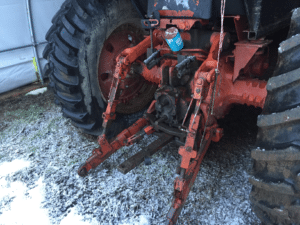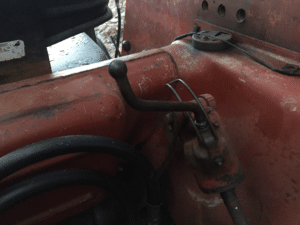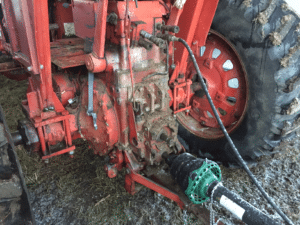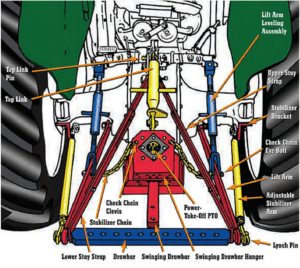The Safe and Efficient Use of Tractor Three Point Hitches
April 4, 2016/
by Rich Taber
Tractors can be wonderful devices to accomplish a whole bunch of different tasks on a farm. Three point hitches are an integral part of most tractors nowadays; they are so useful that even draft horse enthusiasts are adapting some forecarts with such useful devices. However, there are certain guidelines to follow in the use of three-point hitches, for human safety and efficiency of operation.
In my young and poor days, I remember the first tractor on my own farm in the early 1980’s was an ancient 1940’ish John Deere B with no starter, a hand crank flywheel ignition system, no hydraulics, a drawbar, and with no three point hitch, and no muffler. Much like the different stages of life that fishermen go through: stage one, you want to catch many fish and any fish will do (any tractor will do); stage two, you want to catch fewer but bigger fish (tractors with three-point hitches); and stage three, you want to catch the occasional trophy level fish (one or two fairly modern well equipped tractors). At that point in my life I was desperate for any tractor; this was my stage one tractor that set me back $500.00. However, there was very little that I could do with this machine, other than pull wagons with the drawbar. Sadly, I had to part company with this obsolete, inefficient machine. Over the ensuing years I slowly worked my way up the chain with succeeding, but better equipped and safer tractors.
Not all tractor drawn farm implements require the use of a three-point hitch, but many of them do. Haying, tillage, brush hogging, planting, wood splitting, snow removal, broadcast spreading fertilizers, digging postholes, hauling round bales, logging winches; the number of tasks accomplished with a three-point hitch is innumerable.
In my decades as an agricultural educator, I have observed several mistakes that new and beginning farmers make with the use of three point-hitches. Incorrectly and unsafely mounted hitches can result in safety hazards and inefficient use of the implements. Attaching and detaching three-point hitch implements can be fraught with health hazards if proper care and diligence is not taken.
A diagram is included which shows all of the parts of a three-point hitch. It shows a drawbar fastened between the two arms, which is not commonly used, but can be.
Three point hitch implements are normally attached to the top link, and the two bottom ends of the lift arms. You must have the correct types of pins to attach everything, which I collectively call “hitch hardware”. These include lynch pins and pins for both ends of the top links. Some common mistakes are to use incorrectly sized or broken lynch pins and top link pins, and without respect to the proper “category” of hardware. Three-point hitches come in different categories: Category I, Category II, Category III, etc. The take home lesson is that different categories use
different size hardware to fasten the implement to the tractor. I have seen all kinds of “MacGyver”, or less charitably, “cob-job” types of arrangements for hardware, such as using old bolts, nails, or anything else handy to hitch the implement. This is how accidents happen when your implement falls off the tractor at the most inopportune time. A trip to your local farm supply store or machinery dealer should avail to you all kinds of correct hitch goodies that you might need.
Another common error is to not have sway bars attached to the three-point hitch, resulting in implements that whip back and forth and quite unnerving when bouncing over rough or frozen terrain, sometimes causing damage to the implement or tractor tires.
When buying a used tractor, that machine may not have had its three-point hitch adjusted in a long time, hence the three point hitch levelling lever may be long rusted shut. You frequently have to level the hitch before using it, and you will then have to spend time “freeing up” the levelling lever. A healthy supply of WD-40 or its ilk should be kept on hand.
From a safety standpoint, some implements can be hazardous to try to mount, in that they are heavy, awkward, and cumbersome to get correctly attached. Additionally, beware of the three-point hitches on older tractors with obsolete and inconsistent lifting capacities. I once had an empty three-point hitch fertilizer come crashing down on my back, as I was between the spreader and the hitch lever and was reaching forward to the lever to lower it. Nothing much was happening, and I kept slowly lowering the lever when all at once it came crashing down on my back. If the spreader has been full of fertilizer, I may have taken that big trip upstairs many decades ahead of schedule.
A supply of good hand tools, such as ball peen hammers, wrenches, draw pins, and extra hitch hardware should be kept on hand, and a toolbox mounted on one of the tractor fenders to contain all of that will ensure that you always have what you need on hand.
Be safe, be careful and good farming!
Rich Taber of CCE Chenango is a long time farmer, and agriculture and natural resource educator. He lives with his collection of tractors, all but one of which has a three point hitch, on a diversified livestock, poultry, grazing, and woodlot operation in Madison County, named “Great Northern Farm”, which he runs with his wife Wendy who operates the family meat business. He can be reached at 607-334-5841, extension 21, or email: rbt44@cornell.edu.
Posted in Small Farms Quarterly






Nice article. I have never owned a large tractor with a three point hitch but I have seen many and talked with many tractor dealers and farmers, in my tractor tire business. It’s amazing what you can get accomplished with a tractor with a three point hitch. Ingenuity at it’s best.
It would be great to have a good discussion of when to use a swinging drawbar vs. a 3pt drawbar. From the discussions I’ve seen, I can’t see a use for the 3pt drawbar at all if you have a swinging drawbar. I’m pretty sure it’s not that simple, but no one seems to know when it would make more sense to use the 3pt drawbar.
On my Farmall, this isn’t an option, because there’s no 3pt. There’s a fixed rear drawbar where the 3pt drawbar would be. But there’s also a swinging drawbar available to go with that.
I have a three point drawbar, the upper stays, and the lower stabilizer bars, and I pretty much never use all of that. I always use the swinging drawbar. Is the point of the 3pt drawbar so you can lift the bar to match the implement height for hooking up? Because that *is* a pain in the back sometimes.
Hi Ken,
I’d recommend reaching out to the author of the article, Rich Taber, with your suggestion for further discussion and questions. Rich can be reached at 607-334-5841, extension 21, or email: rbt44@cornell.edu.
Swinging drawbars are used when pulling equipment like discs that resist turning. The swinging bar allows the tractor to turn first and then pull the implement from an angle. three points bars are typically used as a substitute for fixed bars or when a little more distance between the tractor and implement are needed. You must be VERY careful with 3 point draw bars especially in hilly terrain and smaller tractors as the added distance often creates an imbalance in weight and can increase turnover rates.
JKMClark, my IH 444 manual explains that the swinging drawbar is preferred as a stronger attachment at a lower position (stability against tipping). The 3-pt drawbar is a convenience (easy height adjustment) for lighter loads and frequent coupling/decoupling.